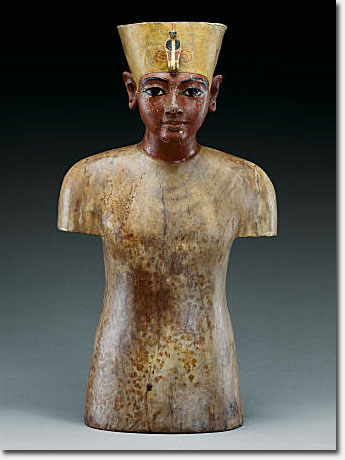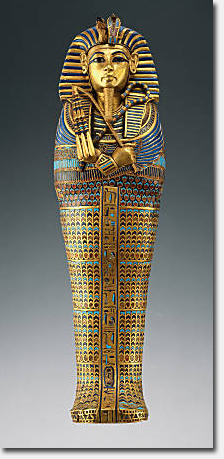 It’s been 30 years since the de Young last hosted King Tut, so this Saturday’s opening of Tutankhamun and the Golden Age of the Pharaohs is sure to be a “golden” ticket.
It’s been 30 years since the de Young last hosted King Tut, so this Saturday’s opening of Tutankhamun and the Golden Age of the Pharaohs is sure to be a “golden” ticket.
While the early birds are awaiting their entry into the much-hyped show, here’s your guide to what’s in the show, how to get tickets and some good historical nuggets. Much of this is from the exhibition’s stellar website, http://tutsanfrancisco.org/.
Who was Tutankhamun?
Tutankhamun was one of the last kings of Egypt’s 18th Dynasty and ruled during a crucial, turmoil-filled period of Egyptian history. The boy king died under mysterious circumstances at the age of 18 or 19, in the ninth year of his reign (1322 BC). Read more about the Boy King
What you’ll see in the exhibit
The exhibition includes over 130 outstanding works from the tomb of Tutankhamun, as well as those of his royal predecessors, his family, and court officials. Tutankhamun’s tomb in the Valley of the Kings was filled with magnificent treasures meant to ensure his divine immortality. Many objects belonging to the young king—exquisite personal items used in his daily life—were placed in it.
On display will be 50 of Tutankhamun’s burial objects, including one of the gold and precious stone inlaid canopic coffinettes that contained his mummified internal organs. Also included are many of the day-to-day objects enjoyed by the young king including a finely crafted child’s chair and an inlaid game board, one of four in the tomb, clearly representing an activity enjoyed by the king. See a preview of the exhibition. Plus, check out the Chronicle’s list of 10 Things Not to Miss at the show.
How and when were these treasures discovered?
Archaeologist Howard Carter and his excavation financier Lord Carnarvon were granted the concession for the Valley of the Kings in Egypt in 1917, and began work where Davis, another excavatro had found objects associated with the king back in 1907. Though much work was done between 1917 and 1922, there was little to show for it, and Carnarvon grew frustrated and decided to end funding for Carter’s work.
Carter decided to focus his work on the one location not yet explored: an area below the tomb of Ramses VI covered in limestone debris and the remnants of ancient workmen’s huts. The area was quickly cleared, and on November 4, 1922, a young boy delivering water jars to the workers uncovered a limestone step cut into the bedrock.
Soon, workers had uncovered the top of a staircase similar to those found in 18th-dynasty tombs. After another day of intense work, the entire staircase and a doorway blocked with stones and plaster were excavated.
On November 26, 1922, Lord Carnarvon, his daughter Evelyn Herbert, and architect Arthur Callendar, anxiously stood by as Howard Carter made an exploratory hole in the doorway. After letting the 3,000-year-old air vent from the chamber, Carter widened the hole and peered inside. As his eyes grew accustomed to the dark, he began to make out the treasures packed haphazardly into the room. He was, in his words, “Struck dumb with amazement. Lord Carnarvon, unable to stand the suspense, inquired “Can you see anything?†to which Carter famously replied “Yes, wonderful things.â€

How did King Tut die?
[From the SF Examiner] It’s a 3,000-year-old mystery that has eluded Egyptologists since the discovery of Tutankhamun’s tomb, and now San Franciscans may be the first to know what really killed the Boy King.
Zahi Hawass, director of the Egyptian Supreme Council of Antiquities and an authority on all things Tut, told a crowd at the de Young Museum on Wednesday that he has developed a new theory as to how Tutankhamun died.
Scholars recently said he died from gangrene after his leg was injured in a chariot accident. Previously, researchers believed he was murdered from a blow to the head. But the debate has raged on.
“Actually, we found evidence now that he died of something else,†Hawass said, only revealing that it had to do with 133 sticks found in the tomb.
The announcement will come in a matter of months and will not only reveal the latest theory on King Tut’s death, but will include his never-before-seen DNA lineage.
 I want to go! What’s the scoop on tickets?
I want to go! What’s the scoop on tickets?
If you want to lay your own eyes on the Boy King and his treasures, you’ll need to buy tickets in advance, at least for these first couple of months until the crowds die down. Don’t just head out to the de Young and expect to get tickets for that same day.
Tickets are available online via Ticketmaster, by phone at 877.TUT.TKTS (877.888.8587), or on-site at the de Young. Prices range from free for children 5 and under up to $32.50 for adults on weekends. Ticket prices are lower if you attend Mon-Thurs. More ticket information (incl. group sales)
Tut at Twilight is another way to get discounted admission. Attend on a Wednesday evening this summer and enjoy discounted admission to the exhibition, convenient parking, evening views from the de Young’s observation tower, and a special prix-fixe menu at the de Young Cafe.
Discounted Tut at Twilight admission is $20 for adults, seniors, students, and groups, and $15 for youth 6–17 and FAMSF members. To qualify for Twilight prices, you must purchase tickets for a Wednesday night showing between 5pm and 7:30pm (the show stays open until 9pm). Get Twilight tickets
What is the exhibition schedule?
June 27–September 30, 2009
October 1, 2009–March 28, 2010
I might not make it. I’ll just see it again in another 30 years.
No you won’t! This is the last time that King Tut’s artifacts will travel out of Egypt. So unless you plan on making your way to Egypt, you’re better off finding the time to make it to the show in your own backyard. After all you have until March 28, 2010!
I’ll be attending the show in a couple of weeks and am looking forward to it.
Sarah B.